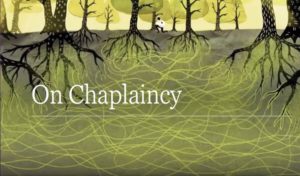Humanist Chaplaincies: Creating a Space for Students

This article is adapted from a session presented at the 81st Annual Conference of the American Humanist Association in July 2022.
My goal is to present a roadmap to explore what humanist chaplaincy means in the current particular moment within higher education. I want to start by presenting two quotes so that we can begin to contextualize the discussion.
The first is from Pray Tell [the character played by Billy Porter in the series Pose]:
Houses are homes to all little boys and girls who never had one, and they keep coming every day, just as sure as the sun rises.
And then the next quote is from bell hooks (1990):
Making homes where all Black people could strive to be subjects, not objects, where we could be affirmed in our minds and hearts despite poverty, hardship, and deprivation, where we could restore to ourselves the dignity denied us on the outside in the public world.
Now, I invite you to think about what these quotes mean to you. At least for me, very superficially, they mean family, meaning, and becoming—and in the context of higher education, these quotes inform my praxis as a humanist chaplain.
Now, who am I? Well briefly, I am Afro-Boricua. I am a first-generation, low-income professional. I do transdisciplinary scholarship, and I’m also a practitioner-activist, I really focus on decolonial thought, anthropology, cultural studies, and humanist advocacy. I am also the humanist chaplain at Tufts University.
Now, as we begin to talk about chaplaincy, I would like participants to begin to think about the question: What does chaplaincy mean to you? What comes to mind? And you can utilize the image that I’ve shared of the mycelium rhizome to help you kind of ground yourself and maybe expand your notions of chaplaincy.
Basically, the image allows us to acknowledge, recognize, and visualize the fact that, within the ecosystems that we’ve seen in the natural world, there is an interconnection and an interdependence, which also the human is part of. We’re connected in terms of a broader ecosystem that goes beyond ourselves and we are part of the animal kingdom. Potentially, I would argue, not the crown of creation, but just a part of the ecosystems.

Anthony Cruz Pantojas uses the metaphor of mycelium to describe chaplaincy in his conference presentation.
I think that it is important to recognize that “chaplain” or “chaplaincy” might be a concept that produces some contestations, some tensions, or disagreements, in particular because it does come from a Christian imagination, a Christian framework. What is a chaplain, historically speaking? It used to be considered that the definition of chaplain is “a little chapel.” So, basically, the chaplain would be an extension of a particular denomination or particular religious community. In our time and space and our current social realities, however, we are to an extent trying to reclaim the fact that humanists, free thinkers, nontheists also have a space, and should be visible, and allowed, and able to do the work of chaplaincy in the context of higher education and also beyond.
Now, what is the significance of humanist chaplaincy? Recently, through the Religion News Service, there was an article published that featured chaplains and chaplaincies across the United States. This piece actually talks about the fact that students are yearning for more fluid, hybrid spaces to find meaning, multiple perspectives, as they try to confront social injustice, find resources, support, mentorship, and a space to call home. I think this is very, very important.
Now a perspective from the field. I work at Tufts University. Historically it is predominantly a white institution. However, we have seen in the past few years, a shift in terms of membership, in terms of participation. The Humanist Community at Tufts, also known as HCAT, is in its eighth year of existence, and it is very important because it is one of the very few humanist chaplaincies that exists in the United States that, as I mentioned before, is saying there is a community of students, staff, faculty, and people from the broader community that share a humanist orientation to life. They identify within the nonreligious/nontheist frameworks and also need a space to be able to engage their student experience, their faculty and staff experiences, as well as looking for places to belong. Why? Because mentorship, facilitating spaces in terms of different topics, themes, ideas, brainstorming. For example, how do we come together to civically engage in a global perspective when social injustices are occurring and happening within our world. These are ways in which, hopefully, through a humanist chaplaincy we see an embodied leadership; meaning that we allow the spaces to be nurtured, cared for, and also hold a continued institutional memory where students can continue to be part of this community of choice, even after they complete their studies, they graduate, or they move on into other and better things in the world.
Also, particularly through my work here at Tufts University some of the programming that I’ve been able to develop in this past academic year has been emergence of rhythms of the human condition, which basically allowed us to create a space where the arts, humanist life stance philosophy, ethics, and spirituality met to discuss what does it mean to explore the human condition in its broadest understanding and framing. I think this is beautiful because the arts, the ecological framing of our world, being civically engaged, being socially active and politically active is very important. We should not exclude the dimensions of the arts, broadly conceived.
Another event that was really powerful and meaningful this academic year was the Unlearning Retreat. Basically it was a space where Black, Brown and Indigenous students of color were able to come to the Interfaith Center and two facilitators, storäe michele and Dr. Jé Hooper, were able to create a container where students had the freedom, the possibility, the imagination, and the abundance of resources (curated for them by myself and a Hindu advisor) to really experience what does it mean to rest, to recharge, to be seen, to be held, to be cared for in spaces. Especially when these spaces are, a lot of times, pulling from us a condition of competition, sometimes alienating ourselves, our communities, our stories and the narratives from which we are coming in higher education. In my experience, and what some of the students said, was that it was the first time—in this space in higher education at Tufts University—that they were seen.
That’s a very powerful statement for me as the humanist chaplain. But also I want to share this so that we can really ponder, when we are thinking broadly about humanist chaplaincy either in higher education or beyond: How do we curate spaces for students where they can really not only have programming, but that they can actually be empowered, they can really embody within themselves leadership skills, be mentored, supervised. They can really bring forth the ability of imagining, or even reimagining, what a student experience looks like when there are humanist chaplaincies.
“Students are yearning for more fluid, hybrid spaces to find meaning, multiple perspectives, as they try to confront social injustice, find resources, support, mentorship, and a space to call home.”
We need to look at the different identities—either religious, philosophical, or spiritual—that students used to describe themselves in responding to a survey at Tufts. More than forty percent of the incoming class of this past academic year identified within the spectrum of nonreligious, nontheist, agnostics, freethinkers, humanists, and in between. This means that there is a need, that there is a population of students that are publicly stating that they identify within this framework. It’s very important to recognize, if these are the students that are publicly deciding to claim these identifiers, what are the rest of the student population saying? Could this number increase as the years move on? Especially might the numbers increase as we sustain humanist chaplaincies in higher education and allow for a continued institutional memory to be strengthened, to be expanded, and to be nurtured in the spaces?
After our programs this year, some of the students were inspired to make and give gifts to the humanist chaplaincy. They shared things like key chains, stickers and books. These were not requested of them, however, they chose to do that for the community. Again, this taps into this reality that if students are given the opportunity, if humanist chaplaincy is given equal representation within higher education and given this institutional communal support from the university and beyond, I think that we see that students begin to really claim the space, this community of choice. The gifts made last year are an example of that.
I want to leave us with these questions about strategies, institutional collaborations, and partnerships to really think about the question: Where we go from here? How can humanism and its institutions interface with discourses and practices around interreligious literacy and engagement? How can humanism be a meaningful orientation for higher education settings to confront this moment that we are living in?
I especially want to center the second question: How can humanism and its institutions interface in terms of practice? Within the American Humanist Association’s Center for Education there is a new partnership with United Theological Seminary in Minneapolis which is going to actually launch in Fall 2022. It allows for humanists, nonreligious, atheists, freethinkers, and other folks in between, to have a home space to receive accredited higher education training, in a multiplicity of disciplines and academic discourses but centered and rooted in the humanist philosophical lifestance by people from the Center of Education and other staff and contingent faculty that will be able to really embody, share, create, and provide a space. We will no longer just be trying to put the pieces together, but really, as I mentioned earlier on, with the mycelium rhizomes, be connected to institutional memory, to other higher education spaces where we are engaging in conversations, where we are really engaging with the other even through difference but in proximity. Hopefully the program will provide trained professionals, chaplains, humanist leaders, humanist clergy, that can really go into the world. Not only with a philosophical, intellectual and academic foundation, but also being enriched by other religious, spiritual, philosophical traditions that are part of the ecosystems in which we currently live.
To conclude, I would love to collaborate with other institutions, would love to help imagine and explore the possibilities of humanist chaplaincy—not only in higher education but beyond that. Given our cyberworld, advanced technologies, we are really able to do amazing programming that supports mentorship even across the world basically. Please support one another in this very critical time of flux, where we really are in a desperate need to be proximate in relationship with each other.
